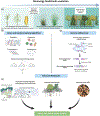Thermophilic microbial deconstruction and conversion of natural and transgenic lignocellulose
- PMID: 33684253
- PMCID: PMC10519370
- DOI: 10.1111/1758-2229.12943
Thermophilic microbial deconstruction and conversion of natural and transgenic lignocellulose
Abstract
The potential to convert renewable plant biomasses into fuels and chemicals by microbial processes presents an attractive, less environmentally intense alternative to conventional routes based on fossil fuels. This would best be done with microbes that natively deconstruct lignocellulose and concomitantly form industrially relevant products, but these two physiological and metabolic features are rarely and simultaneously observed in nature. Genetic modification of both plant feedstocks and microbes can be used to increase lignocellulose deconstruction capability and generate industrially relevant products. Separate efforts on plants and microbes are ongoing, but these studies lack a focus on optimal, complementary combinations of these disparate biological systems to obtain a convergent technology. Improving genetic tools for plants have given rise to the generation of low-lignin lines that are more readily solubilized by microorganisms. Most focus on the microbiological front has involved thermophilic bacteria from the genera Caldicellulosiruptor and Clostridium, given their capacity to degrade lignocellulose and to form bio-products through metabolic engineering strategies enabled by ever-improving molecular genetics tools. Bioengineering plant properties to better fit the deconstruction capabilities of candidate consolidated bioprocessing microorganisms has potential to achieve the efficient lignocellulose deconstruction needed for industrial relevance.
© 2021 Society for Applied Microbiology and John Wiley & Sons Ltd.
Figures


References
-
- Alzagameem A, Bergs M, Do XT, Klein SE, Rumpf J, Larkins M et al. (2019) Low-input crops as lignocellulosic feedstock for second-generation biorefineries and the potential of chemometrics in biomass quality control. Appl Sci 9: 2252.
-
- Balch ML, Chamberlain MB, Worthen RS, Holwerda EK, and Lynd LR (2020) Fermentation with continuous ball milling: Effectiveness at enhancing solubilization for several cellulosic feedstocks and comparative tolerance of several microorganisms. Biomass Bioenerg 134: 105468.
-
- Balch ML, Holwerda EK, Davis MF, Sykes RW, Happs RM, Kumar R et al. (2017) Lignocellulose fermentation and residual solids characterization for senescent switchgrass fermentation by Clostridium thermocellum in the presence and absence of continuous in situ ball-milling. Energy Environ Sci 10: 1252–1261.
Publication types
MeSH terms
Substances
Grants and funding
LinkOut - more resources
Full Text Sources
Other Literature Sources

